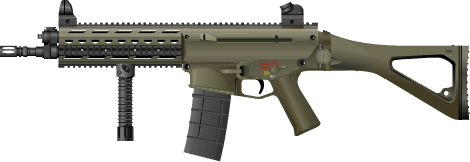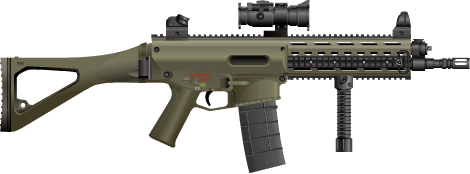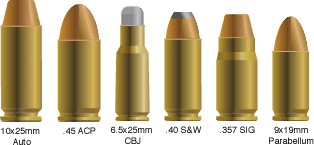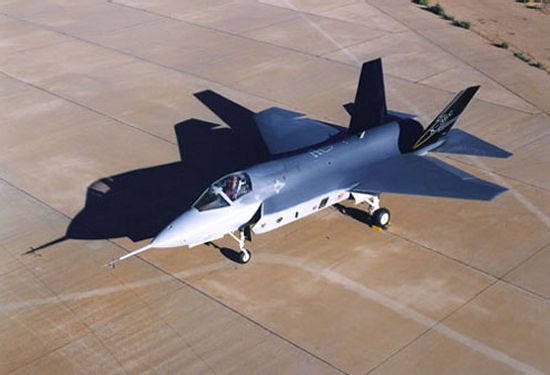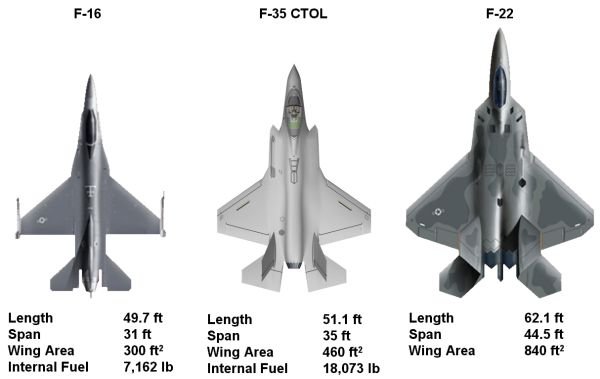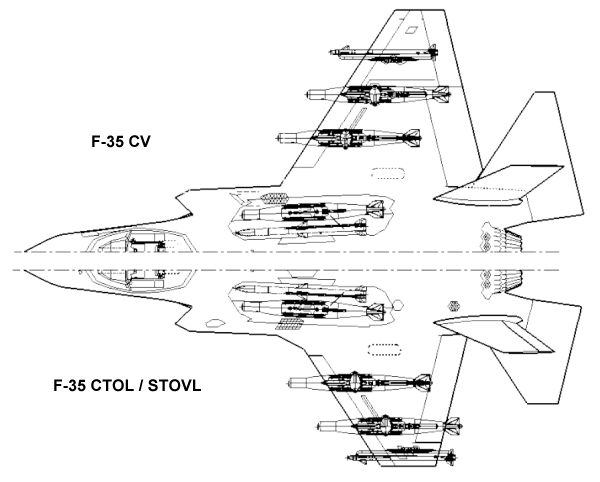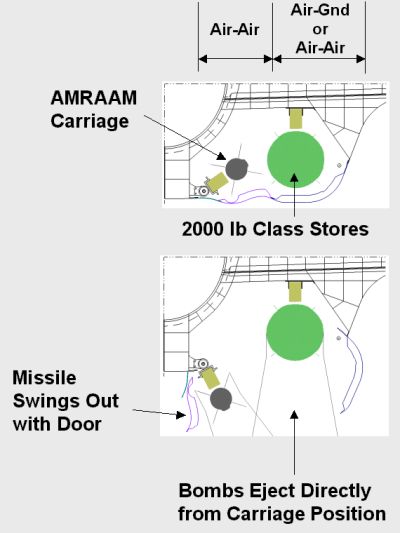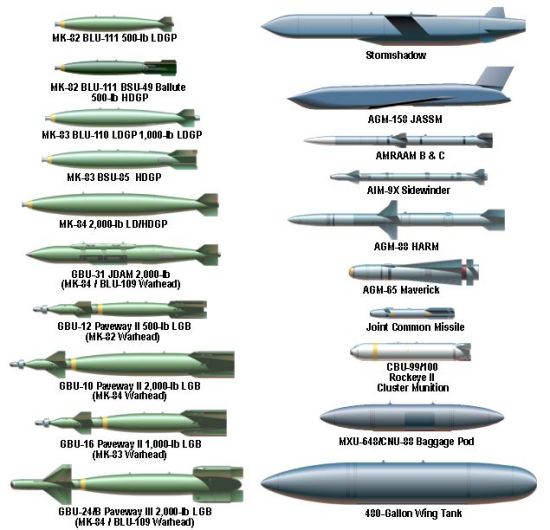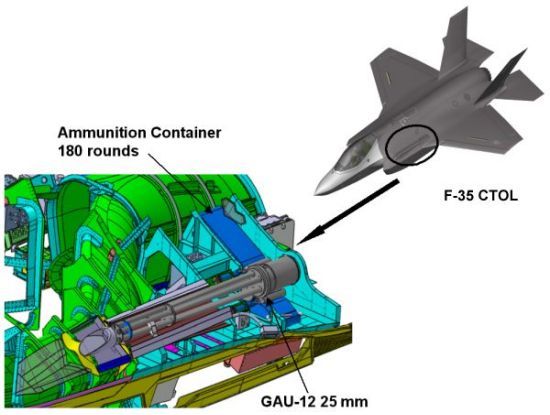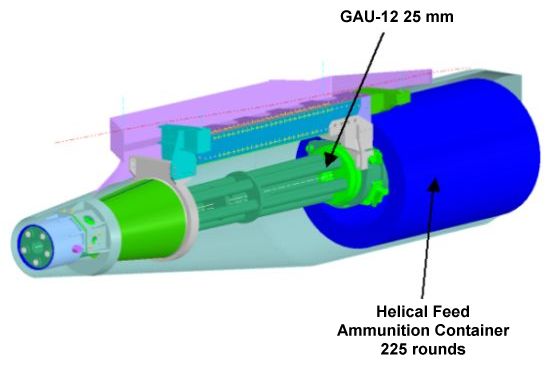 P270B Diablo Long Slide Pistol shown w/ OD green Zytel polymer frame and black oxide finish slid)
P270B Diablo Long Slide Pistol shown w/ OD green Zytel polymer frame and black oxide finish slid)
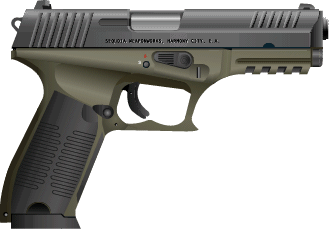
P270B Diablo Combat Pistol

P270B Diablo Tactical Pistol
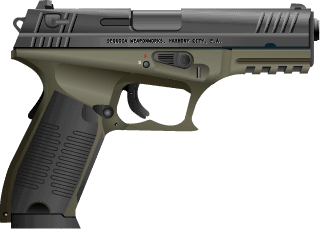
P270B Diablo Duty Pistol (Military & Law Enforcement)
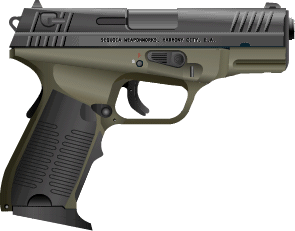
P270B Diablo Compact Pistol: an ideal backup or off-duty sidearm for military and law enforcement personnel
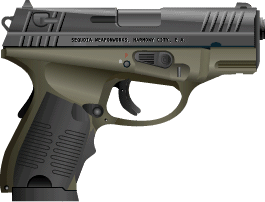
P270B Diablo Subcompact PistolSPECIFICATIONSCalibre: 6.5x25 mm CBJ, 9x19 mm Parabellum, .357 SIG (9x21 mm), .40 S&W, (10x21 mm), 10x25 mm Auto, .45 ACP (11.43x23 mm)
Action: short recoil, locked breech, double action/single action
Locking: Browning type, linkless
Models: Long Slide, Combat, Tactical, Duty, Compact, Subcompact
Weight:- Long Slide: 1.08 kg empty, 1.29 kg loaded
- Combat: 1.04 kg empty, 1.25 kg loaded
- Tactical: 1 kg empty, 1.21 kg loaded
- Duty: 0.92 kg empty, 1.13 kg loaded
- Compact: 0.87 kg empty, 1.08 kg loaded
- Subcompact: 0.66 kg empty, 0.84 kg
Overall length:- Long Slide: 240 mm
- Combat: 224 mm
- Tactical: 245 mm
- Duty: 218 mm
- Compact: 194 mm
- Subcompact: 173 mm
Barrel length:- Long Slide: 132 mm
- Combat: 129 mm
- Tactical: 129 mm
- Duty: 127 mm
- Compact: 108 mm
- Subcompact: 92 mm
Cartridge: high-pressure +P loads, rimless straight ball
Rifling: polygonal, 6 groove, right hand twist w/ 1 turn in 9.8” (250 mm)
Ammunition: FMJBT, FMJ, JHP, frangible
Feed system: detachable box magazine, double column
Capacity:- Long Slide: 12+1 (.45 ACP, 10 mm Auto)
- Combat: 20 (6.5 mm CBJ), 15+1 (9 mm Para), 14+1 (.357 SIG, .40 S&W), 12+1 (.45 ACP, 10 mm Auto)
- Tactical, Mil/LE, Compact: 15+1 (9 mm Para), 14+1 (.357 SIG, .40 S&W), 12+1 (.45 ACP, 10 mm Auto)
- Compact: 15+1 (9 mm Para), 14+1 (.357 SIG, .40 S&W), 12+1 (.45 ACP)
- Subcompact: 10+1 (9 mm Para), 8+1 (.357 SIG), 7+1 (.45 ACP)
Muzzle velocity: 397 m/s (9 mm Para), 440 m/s (.357 SIG), 410 m/s (10 mm Auto), 389 m/s (.40 S&W), 313 m/s (.45 ACP)
Chamber pressure: 43,000 psi (6.5 mm CBJ), 35,000 psi (9 mm Para, .357 SIG), 32,000 psi (.40S&W), 23,000 psi (10 mm Auto), 37,500 psi (.45 ACP),
Practical rate of fire: 40 rpm
Safety/selector:- All models: automatic firing pin block, trigger safety, decocker/safety lever, loaded chamber indicator
- Duty, Compact, Subcompact models: additional grip safety on backstrap, thumb safety
Modes of fire: safe + single shot + semi-auto
Trigger:- Long Slide, Combat, Tactical: SA, DA/SA
- Duty, Compact: DAO, DA/SA
- Subcompact: DAO
Trigger pull:- SA: 20 N
- DA/SA: 27.5 N + 11 N
- DAO: 32.5
Maximum effective range: 50 m
Sights: square blade and rear notch, 3-dot combat w/ Tritium inserts, dovetail mount
Finish: matt black slide, matt black (Zinaire-pattern) or OD green (Arcturian-pattern) furniture
Equipment: Emerson Optronics MK 2 Multifunction Illuminator, muzzle compensator/sound suppressor, tactical block w/ breech teeth
HISTORYThe P270B “Diablo” is a slightly enlarged and enhanced version of the original P270A “Diablo” range of handguns which it will replace in serial production during 2009. The P270A has since it’s introduction in 2007 been widely exported and licensed in a number of nations including Imperial isa, Zinaire, Alfegos, Leistung, Madurastan, Cazatania, Central Prestonia, Oily Prata, Coorsota, Ustia, Aissur and Parilisa. It is also the standard sidearm of the ODEPOL and ODEFOR agencies of the Oceanic Defense Coalition.
The P270B “Diablo” builds on the key qualities of its predecesor by combining its outstanding accuracy, quality and reliability with a number of improvements. These include a new manually operated external safety and decocker, a crisper adjustable trigger pull, improved ergonomic frame and grip, a under-molded universal MIL-STD-1913 Picatinny rail, a well supported chamber designed from the outset to feed and fire +P loadings and .40/10mm factory ammunition and handloads, a loaded chamber indicator, and new higher capacity magazine feed system.
TECHNICAL DESCRIPTIONThe P270B “Diablo” Handgun System is a family of short recoil operated, locked breech, semi-automatic magazine fed handguns chambered in a variety of popular hand gun cartridges including 9 mm Parabellum, .357 SIG, .40 S&W, 10 mm Auto and .45 ACP.
The P270B has been designed for military, para-military and law enforcement applications and includes four full-sized high capacity service models (Long Slide, Combat, Tactical and Duty); and two concealed carry models (Compact and Subcompact) that have shortened slides, barrels, grip frames and dust covers.
ConstructionThe frame and reciever are made of abrasion and impact resistant DuPont Zytel Super Tough ST-8018 polymer (14% short glass-fibre reinforced Nylon 66 polyamide) over a lightweight AISA 416 stainless steel chassis. Removable non-slip side panel pistol grips are made of Carbon Kevlar (a carbon-fibre and Kevlar aramid fibre mixed weave in an epoxy resin matrix.) These panels do not shrink, warp, crack or splinter under stress like rubber or wood, and will protect the firer’s hand from an explosive slam-fire failure of the weapon. There is a customer choice in furniture finish between olive drab green (A Pattern or “Arcturian” pattern) or matt black polycoat (Z Pattern or “Zinaire” pattern).
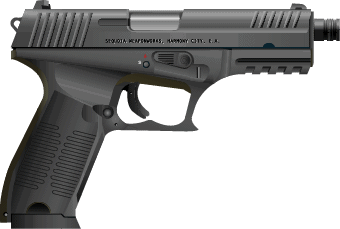 A P27OB Diablo Tactical Pistol, Z Pattern black polycoat finish, as issued to ODEPOL and ODEFOR personnel
A P27OB Diablo Tactical Pistol, Z Pattern black polycoat finish, as issued to ODEPOL and ODEFOR personnelThe slide, barrel, breech and bolt are milled from AISA 416 chromium-nickel stainless steel solid blanks. The barrel is of two piece construction and has a chromium plated rifled polygonal bore that reduces deformation of the bullet and enchances velocity. The polygonal rifling is six grooved with a right hand twist and lacks corners at the bottom of the grooves where fouling would otherwise accumulate. The slide has a corrosion resistant salt bath nitriding Tennifer surface finish. Internal metal parts, including springs, are coated with a special Dow Corning anti-corrosion process to reduce friction and wear.
ErgonomicsParticular attention was focused on redesign of the frame, which has a more ergonomic grip with a removable backstrap and grip panels, a finger grove frame reccess and a 111° grip angle that balances the weapon at the natural shooting point of the hand. A MIL-STD-1913 Picatinny rail is noow molded underneath the barrel on the front reciever for use with tactical accessories (see below).
The trigger guard has been reduced from the first generation P270A model but remains oversized for use with gloves, and a recurved hook for the index finger is also retained on Combat and Tactical models. The slide is radiused and smoothed so as to be snag free and allow quick draw from a holster, the Duty, Compact and Subcompact models also having an unsual sloping angle (again borrowed from the P270A model) for superior draw. The slide also has deep widely spaced cocking serrations on the front and rear ends for superior grip when handling with wet or gloved hands.
ActionThe P270B is striker fired, with an internal firing pin safety and exposed hammer. The operating system is based on a modified Browning-type linkless cam-locked breech action using a shaped cam to withdraw the barrel from engagement with the slide. The rifled barrel is secured in place by a steel cross pin to the frame and fits to the chamber, locking surfaces and a rear unlocking lug, that also controls movement of the slide and ejection port. The recoil buffer is a captive dual recoil spring system, this being a buffering spring telescoping a piston containing a return spring fixed to the forward stop underneath the barrel.
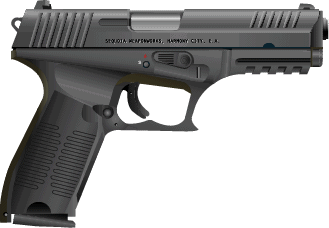 (A P27OB Diablo Combat Pistol with a legacy P270A pattern magazine inserted into the grip
(A P27OB Diablo Combat Pistol with a legacy P270A pattern magazine inserted into the gripThe feed system is a tapered double column magazine, except for the Subcompact model that uses a single column magazine to fit a slimmer grip. Magazines load into a bevelled polymer framed magazine well designed for quick operation. Older P270A pattern magazines can feed and fire but will not fit exactly into the new grip. The new magazines are constructed of corrosion resistant stainless steel polished to a No. 8 mirror finish for frictionless drop free operation, and have a black polymer floor plate that provides an extended finger rest.
The well supported chamber design is fully compatible with high pressure +P ammunition, and standard and specialised loads including frangible rounds for safe take down of subjects in a pressurised aircraft cabin, and a saboted light armour piercing (SLAP) round able to defeat US NIJ Level III body armour. A low barrel bore axis and crisp trigger pull reduces felt recoil and muzzle flip for greater accuracy on the first shot and multi-shot strings, and allowing faster indexing of the front sight during follow-up shots.
TriggerThere is a choice of a single action (SA) trigger with automatic safeties, combination double-action/single-action (DA/SA) with optional decocker and manual safeties providing the additional option of firing in either SA or DA mode, and a self-cocking double action only (DAO) firing mechanism.
Trigger pull weight is adjustable between a short and light 6.6 newton (N) (1 1/2 lbs) and a long and heavy 45.5 N (10 lbs), all having a 3 mm (1/8 inch) of travel. DA/SA provides a heavy 27.5 N (6 lbs) trigger pull on the first shot and a lighter 11.25 N (2 1/2 lbs) trigger pull on all subsequent shots. DAO is optimised for combat shooting with a typical 32.5 N (7 1/4 lbs) two-stage pull that has a crisp and sudden let off and very short trigger reset, while SA has the same weight of pull with a shorter reach.
SafetiesThe P270B is equipped with multiple redundant safety and indicator systems designed to enhance the pistol's safety and reliability. These consist of automatic drop, firing pin block and out-of-battery safeties, a trigger safety lock and manual safeties. There is also a magazine release button and slide stop for rapid reloading. A loaded chamber indicator is located atop the slide just behind the ejection port that engages whenever a cartridge is in the chamber, and is a non-protruding red coated pin that can also be felt by hand in the dark.
The Duty, Compact and Subcompact models have an additional squeeze-cocker grip safety and thumb safety located on the left side of the slide that locks both sear and slide. All models have common safety features that allow the gun to be carried “locked and cocked” at Condition One for instant deployment. This comprises an ambidextrous frame safety/decocker lever that disconnects the trigger and hammer and a trigger safety lever that locks the trigger from moving backwards and must be depressed to release and fire the weapon.
SightsThe slide is milled with dovetails that will accept a wide variety of factory and aftermarket tritium self-luminous sights. The suplied sight is a three-dot combat type with a rear notch adjustable for windage (1 click per 0.5 MOA) and a front blade. Both sights are machined from lightweight solid billet 6061 T6 aircraft grade aluminum alloy. There is one large front dot and two rear dots, each being a glass lamp filled with pressurized tritium gas that glows a bright green at night or in low light, while inlaid white rings provide a white dot in daylight.
TACTICAL ACCESORIESEmerson Optronics MK 2 Multifunction Illuminator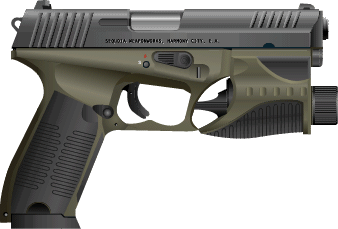 P270B Diablo Combat Pistol with a MK 2 Multifunction Illuminator mounted on underbarrel accessory rail
P270B Diablo Combat Pistol with a MK 2 Multifunction Illuminator mounted on underbarrel accessory railThe MK 2 Multifunction Illuminator is a combination infra-red and visible light solid state Class IIIa laser aiming module weighing only 127.5 g. It is housed in a fully sealed, ruggerised, weather-proof polymer housing and is mountable to its host weapon by a MIL-STD-1913 Picatinny rail. The unit can be boresighted to the weapon and will retain zero when removed and remounted. An activator switch lever on the module is positioned just forward of the trigger guard for easy operation, or the illuminator can be controlled using a remote cable switch attached to the pistol grip.
The laser diode produces a peak power of 7 milliwatts (mw) adjustable by a temperature compensating circuit to ensure a constant eye-safe power output level of 650 nanometres (nm). The laser diode is selectable between two visible light modes: flashlight mode (95 lumens brightness, range 50 metres) and aiming spot mode (range 30 metres in daylight and 450 metres in low light). The infra-red aiming spot mode has a range of 50 metres and is clearly visible to 2nd and 3rd generation night vision devices.
SOCOM-style muzzle compensator/sound suppressor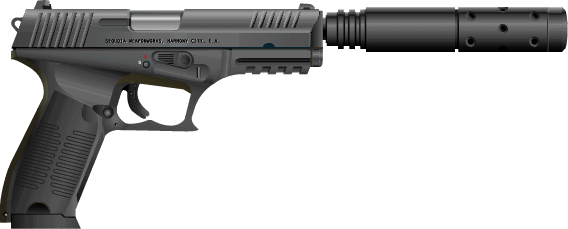 P270B Diablo Combat Pistol with SOCOM-style supressor mounted
P270B Diablo Combat Pistol with SOCOM-style supressor mountedThe SOCOM-style supressor is a quick attach/detach combined muzzle compensator and sound suppressor that reduces noise, flash and recoil. It is mounted by muzzle threads and can be mounted and unmounted with no effect on weapon accuracy or zero. The supressor consists of an outer body of lightweight hard matt black anodised 6061 T-6 aircraft grade aluminum alloy, and inner vortex generating baffles for difussing muzzle propellant gases consisting one symmetrical blast baffle of ordnance grade MIL-A 46100 steel armour plate and several asymmetrical baffles of 2024-T3 aluminium alloy separated by spacers. The supressor is dry and maintenance-free in operation and can reduce recoil by 50%, sound signature to 28-33 decibels (dB), and totally elimninates muzzle flash.
Tactical Breaching Block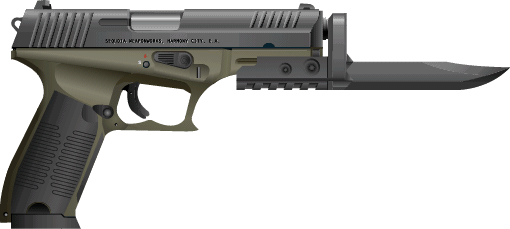 P270B Diablo Combat Pistol with tactical block with breech teeth and removable bayonet blade mounted on underbarrel accessory rail
P270B Diablo Combat Pistol with tactical block with breech teeth and removable bayonet blade mounted on underbarrel accessory railThe tactical block is a stand-off muzzle device mounting by the reciever rail of a P270B. It provides an unobstructed aperture that does not touch the barrel, and is of lightweight hard anondized aluminium alloy construction so as not to adversely affect balance or accuracy of the host weapon. A MIL-STD-1913 Picatinny rail is provided underneath for mounting tactical accessories. Four breach teeth protrude from the block that allow the firer to discharge into a door lock, window pane, or other obstacle without making contact at the muzzle, and is also usable as a skull crusher. There is a slot and locking mechanism to secure a M3-type bayonet blade by its tang. This may be used as a retention tool to prevent a bad guy from grabbing the gun during close quarters combat (CQC) such as room clearing.
SUMMARYModel- P270B “Diablo” Handgun System
Versions - Service: Long Slide, Combat, Tactical, Duty
- Concealed carry: Compact, Subcompact
Features- Well supported chamber design able to fire +P and hand loaded ammunition
- High capacity magazine feed system
- Stainless steel slide, barrel, breech and bolt
- Scratch, impact and shock resistant Zytel polymer frame and reciever
- Improved ergonomics with redesigned frame and trigger guard
- Ideal 111º degree angle grip
- Replaceable backstrap and grip panels for comfort
- Automatic firing pin block and out-of-battery safety
- Choice of multiple redundant manual safeties including thumb safety, grip safety and safety/decocker lever
- Loaded chamber indicator
- Under-molded MIL-STD-1913 Picatinny rail on receiver
- Devetail mounts for factory and aftermarket sights
OEM Accesories- Muzzle compensator/sound suppressor
- MK 1 Multifunction Illuminator
- LED tactical flashlight
- Extended magazine baseplate
- Tactical block with breech teeth and removable bayonet blade
MODELSAvailable pistol cartridge chamberingsEach pistol is supplied with three magazines, a cleaning and maintenance kit in a nylon pouch, and a printed instruction manual. A lifetime warranty is supplied on all purchases.
- P270B “Diablo” Long Slide, SA or DA/SA, cal. 10 mm Auto, 5.2” (132 mm) barrel
- P270B “Diablo” Long Slide, SA or DA/SA, cal. .45 ACP, 5.2” (132 mm) barrel
- P270B “Diablo” Combat Pistol, SA or DA/SA, cal. 6.5x25 mm CBJ, 5” (129 mm) barrel
- P270B “Diablo” Combat Pistol, SA or DA/SA, cal. 10 mm Auto, 5” (129 mm) barrel
- P270B “Diablo” Combat Pistol, SA or DA/SA, cal. .45 ACP, 5” (129 mm) barrel
- P270B “Diablo” Tactical Pistol, DA/SA, cal. 9x19 mm Luger/Para, 5” (129 mm) barrel
- P270B “Diablo” Tactical Pistol, DA/SA, cal. .357 SIG, 5” (129 mm) barrel
- P270B “Diablo” Tactical Pistol, DA/SA, cal. .40 S&W, 5” (129 mm) barrel
- P270B “Diablo” Tactical Pistol, DA/SA, cal. 10 mm Auto, 5” (129 mm) barrel
- P270B “Diablo” Duty Pistol (Military & Law Enforcement), DAO or DA/SA, cal. 9x19 mm Luger/Para, 5” (127 mm) barrel
- P270B “Diablo” Duty Pistol (Military & Law Enforcement), DAO or DA/SA, cal. .357 SIG, 5” (127 mm) barrel
- P270B “Diablo” Duty Pistol (Military & Law Enforcement), DAO or DA/SA, cal. .40 S&W, 5” (127 mm) barrel
- P270B “Diablo” Compact Pistol, DAO or DA/SA, cal. 9x19 mm Luger/Para, 4 1/4” (128 mm) barrel
- P270B “Diablo” Compact Pistol, DAO or DA/SA, cal. .357 SIG, 4 1/4” (128 mm) barrel
- P270B “Diablo” Compact Pistol, DAO or DA/SA, cal. .40 S&W, 4 1/4” (128 mm) barrel
- P270B “Diablo” Subcompact Pistol, DAO, cal. .357 SIG, 3 1/2” (91 mm) barrel
- P270B “Diablo” Subcompact Pistol, DAO, cal. .45 ACP, 3 1/2” (91 mm) barrel


